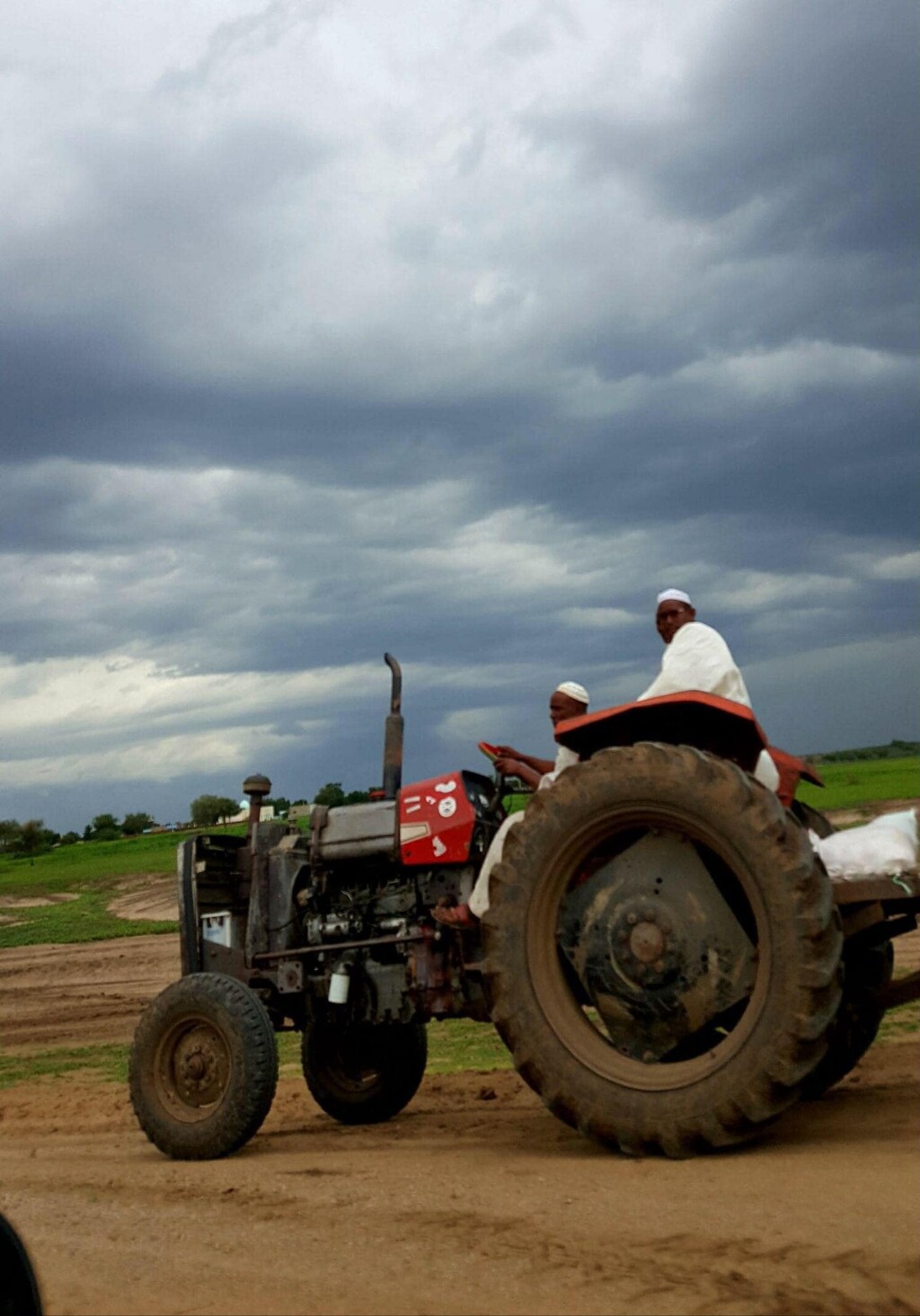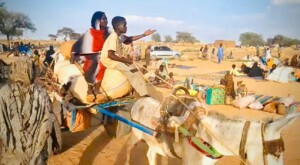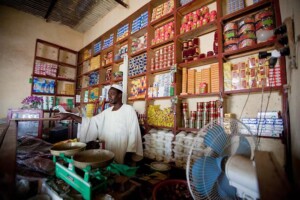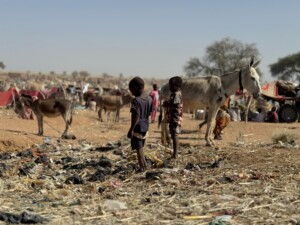Eastern Sudan farmers ‘optimistic’ about upcoming harvest

Sudanese farmer drives tractor in the city of Dinder in Eastern Sudan (Photo: Omar Jalal)
In eastern Sudan, the head of the agricultural committee of the New Halfa Agricultural Project in Kassala told Radio Dabanga that crops, especially cotton, in the southern areas are growing well with improved rainfall and international support key factors in their recovery.
According to the head of the committee, the amount of rain this season has been balanced and beneficial, compared to previous seasons. “There have been high rates of rainfall which is much better.”
In an interview with Radio Dabanga yesterday, he said: “Unusually, the success of the summer agricultural season this year is linked to the very encouraging support from international organisations concerned with food production.” This reportedly allowed for increased cultivation of peanuts and sorghum.
He said that he was optimistic about the availability of food for the agricultural season 2024 to 2025, with support from international organisations acting as a “precaution” against further food shortages in Sudan. He attributed a “delay” in inspections of the northern part of the project to the delay of the arrival of water flowing from the south to the north.
The summer planting season, which concurs with the rainy season from July to September, is the main crop production season, primarily for staple food crops sorghum and millet. Sudan’s lean season takes hold between June and September when food is typically hardest to access due to food supplies from the previous harvest becoming less plentiful or even running out, and new crops not being ready yet.
Sudan’s “food security, agricultural output and future prospects are increasingly under threat as a result of its ongoing civil war,” reported World Economic Forum on March 19. “We’re here because the risk of famine is real. The food security situation is concerning. But we have an opportunity to respond,” Rein Paulsen, director of UN Food and Agriculture Organization (FAO)’s Office of Emergencies and Resilience, told UN News, speaking from the coastal city of Port Sudan on April 19.
International pledges of support
The FAO support programmes for wheat producers in Sudan consist of a grant covering 20 per cent of production inputs directly to farmers, including seeds, fertilizers, and herbicides. The program, which was supposed to start in 2021 but was delayed due to the October 25 coup, is planned to continue for three seasons.
The program benefits 9,200 farmers in New Halfa and began by implementing widespread irrigation systems in the area in 2022. Last year, FAO reportedly supported more than five million Sudanese people with emergency agricultural assistance. The organisation requires $104 million to support just over 10 million Sudanese this year but has received less than 10 per cent of the funding.
He said that they also received firm promises from the World Food Program (WFP) to provide full support for the wheat crop in the winter season 2024 to 2025. Other organisations such as Mercy Corps reportedly aim to provide fertilizers and seeds for vegetables and fruit.
The grip of the Agricultural Bank
The committee head criticised the management of the New Halfa Agricultural Corporation, “which has not provided any financial services for the summer season.” He expressed his dissatisfaction that “cotton, which should be the most important crop in all irrigated projects, was abandoned by the state to make way for capitalist companies to legislate contractual farming programs.”
“The Agricultural Bank provides financing with a limited ceiling that does not meet the input needs of a single farmer, and requires a high-profit margin,” he said. Farmers have been pushing complaints about the poor management of the successive administrations of the Agricultural Bank, he said. “We mentioned this several times, the last of which was in a comment on the production plan for the wheat crop issued by the Planning and Research Department of the New Halfa Agricultural Authority for the 2023 to 2024 season.”
The farmers demanded that they may “escape from the grip of the Sudanese Agricultural Bank to avoid the exorbitant prices of fertilisers that were supplied from the Agricultural Bank through suspicious deals.” Over the last two years, farmers in New Halfa have allegedly incurred huge losses due to the rising cost of fertilisers.
Cooperative societies
“The return of agricultural cooperative societies has become an urgent necessity for all farmers,” said the head of the New Halfa committee. A ‘Field Day’ organised by the Agricultural Research Authority in Hajar village was attended by the New Halfa Agricultural Foundation, government representatives, and Paulsen in April. He said that in this meeting, Paulsen called on farmers to organise under the umbrella of cooperative societies as it is difficult to support them through the government apparatus.
Before the war broke out in Sudan on April 15, 2023, farmers already had a fractious relationship with the Sudanese government and state authorities. In September 2022, new fees for irrigation water services in national projects announced by the government were called “arbitrary” by Abdeen Bargawi, the official spokesperson for the Farmers Alliance, who stressed the farmers’ inability to pay them. In 2017, the New Halfa agricultural projects “did not receive planned support from the East Reconstruction Fund, despite their promises,” Farmer Yasir Shaheen told Radio Dabanga at the time. Eastern Sudan has also faced the brunt of several countrywide fuel and water crises since 2018, causing friction between the pastoral tribes over water resources and grazing areas in the region.
Poor productivity
“With Sudan and its neighbours facing one of the worst displacement crises in the world, according to the UN’s WFP, the pressure on already scarce food resources will be even greater,” the World Economic Forum reported in March.
New Halfa Sugar Factory is facing significant challenges related to electricity supply, skilled labour, seasonal labour shortages, and high production costs. The factory, covering an area of 40,000 acres, was designed to produce around 60,000 tonnes of white sugar but has only managed about 20,000 tonnes annually in recent years.
With less than a third of Sudan’s viable farmland currently in production, and the devastation of civil war hindering production even further, New Halfa and the rest of Sudan’s farmers are under significant pressure to produce enough food “for the sake of millions of lives hanging in the balance,” according to a tweet on X by FAO Director Qu Dongyu on June 27.
Historical overview
The New Halfa Agricultural Project covers an area of approximately 164,000 feddan. The land is distributed between 24,000 farmers, who received 14.5 feddan each when the project started in 1964. The project draws its water from the Atbara River. It is located 400 kilometres east of Khartoum in Kassala and was built to house 52,000 Nubians displaced from Wadi Halfa. Wadi Halfa is situated on the Nile in Northern State, and the old town was flooded when Sudan agreed that Egypt could form Lake Nasser behind the Aswan Dam.
People demonstrated in Wadi Halfa on October 23 and 24, 1960, against being resettled. On 26 October demonstrations took place in the Sudanese capital, Khartoum, which had to be dispersed by police using tear gas. The New Halfa Project has been largely viewed as inadequate compensation for the inundation of Wadi Halfa.











 and then
and then